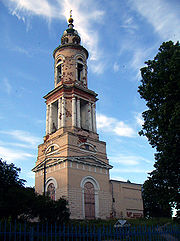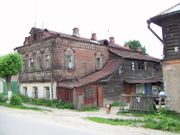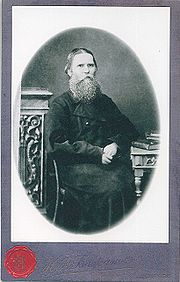
Pavlovsky Posad
Encyclopedia
Pavlovsky Posad is a town and the administrative center of Pavlovo-Posadsky District of Moscow Oblast
, Russia
, located 68 kilometres (42.3 mi) from Moscow
, at the confluence
of the Klyazma
and the Vokhna Rivers. Population:
The Moscow–Vladimir
railway goes through the town.
 Pavlovsky Posad was founded in 1845 on the site of a village Pavlovo (Vokhna
Pavlovsky Posad was founded in 1845 on the site of a village Pavlovo (Vokhna
). The place was always famous for its businesses. From its very foundation, the land on which the town stands belonged to the Trinity Lavra of St. Sergius monastery of the Russian Orthodox Church
. Later (from the middle 17th century) the land came into state ownership. Because of this peculiarity of the place, Pavlovsky Posad never knew serfdom
.
Pavlosky Posad was always famous for its shawl factories. One of these factories - Pavlovo-Posadkaya Manufactura - is still working and producing shawls and kerchiefs in the Russian style.
The very fact of creation of a town (Posad
) on the site of several villages (Pavlovo, Dubrovo, Zaharovo and Melenki) was not typical for 19th century Russia. It was only because local merchants were very energetic, enterprising and rich that this task was accomplished successfully. From the very beginning Pavlovsky Posad has had the textile industry as its main business. Town status was granted in 1844.

 In the middle of the 19th century competition between two groups of merchants in Pavlovsky Posad became very strong. One group consisted of residents of the central part of the town (former Pavolov), whereas the second group originated from the neighboring villages (Stepurino, Prokunino, Evseevo). The competition became even fiercer after 1822 since members of the first group (led by the D.I. Shirokov) were Popovtsy
In the middle of the 19th century competition between two groups of merchants in Pavlovsky Posad became very strong. One group consisted of residents of the central part of the town (former Pavolov), whereas the second group originated from the neighboring villages (Stepurino, Prokunino, Evseevo). The competition became even fiercer after 1822 since members of the first group (led by the D.I. Shirokov) were Popovtsy
Old Believers
, inclined to enter edinoverie
, whereas the second group (led by Ya. I. Labzin) were Bezpopovtsy Old Believers
(Luzhkovskoe soglasie). In 1840 Ya. I. Labzin and his relative V.I. Gryaznov
entered official Orthodoxy and so became much more desirable for the state power, so the second group of businessmen won out over their competitors as a result. The factory of Ya. I. Labzin and V.I. Gryaznov became the biggest shawl-producing factory in Russia
; it is that factory that survived even after the Soviet era.
During the late 19th and early 20th centuries, a lot of beautiful churches and one monastery were built in Pavlovsky Posad.
For his missionary work among the old believers V.I. Gryaznov
was recognised as a local saint
in 1999.
industry is still the most prominent in modern Pavlovsky Posad. During the 1990s the major part of textile factories were transformed into public corporations, than considered to be bankrupt, and then bought for an understated price by local businessmen. The free float index for these factories is currently extremely low (about 90-95% shares of each factory are owned by one person).
After the collapse of the Soviet Union, and to our time, the textile industry is in a very bad state in Russia, since the competition with Asian countries was too sudden and to strong for them to survive. However, some of the factories survived by finding their narrow product niches. The most famous factory of Pavlovsky Posad - the 'Pavlovo-Posadskaya Manufactura' is still producing traditional Russian kerchief
s and shawl
s; and since it's the only shawl mass-producing factory in modern Russia, its financial state seem to be rather good. Some other factories survived by concentrating on fire-equipment (such as fire hose
s), whereas some other are producing vestment
s for Orthodox priests.
The second important factory of Pavlovsky Posad - the 'Exciton', that produced Russian personal computers 'BK' in 1980s, is also formally alive, but it seem not to be concerned with electronics any more.
(This part of an article is based on publications in Pavlovsky Posad local press)

, who was Vasily Gryaznov
's saint patron). A cathedral also has a belltower. Both the cathedral and the belltower are built in the so-called pseudo-Russian style. There's also a little church of St Andrey Rublev at the monastery gates.
For centuries the spiritual center of Vokhna, and later of Pavlovsky Posad, was the 'Voskresensky Sobor' (the Resurrection
Cathedral), located on the left bank of the Vokhonka River. During the Soviet era the main body of the cathedral was demolished, and only a great bell tower and one side-altar preserved.
There are also three more Orthodox churches and one Old Believers Orthodox church, some interesting 19-century factory buildings, a local museum, a museum of Russian shawls and kerchiefs, an exhibition centre. Some old tombstones could be found on local Old Believer's cemeteries. There are also a lot of nice old buildings at the streets of the town center.
Moscow Oblast
Moscow Oblast , or Podmoskovye , is a federal subject of Russia . Its area, at , is relatively small compared to other federal subjects, but it is one of the most densely populated regions in the country and, with the 2010 population of 7,092,941, is the second most populous federal subject...
, Russia
Russia
Russia or , officially known as both Russia and the Russian Federation , is a country in northern Eurasia. It is a federal semi-presidential republic, comprising 83 federal subjects...
, located 68 kilometres (42.3 mi) from Moscow
Moscow
Moscow is the capital, the most populous city, and the most populous federal subject of Russia. The city is a major political, economic, cultural, scientific, religious, financial, educational, and transportation centre of Russia and the continent...
, at the confluence
Confluence
Confluence, in geography, describes the meeting of two or more bodies of water.Confluence may also refer to:* Confluence , a property of term rewriting systems...
of the Klyazma
Klyazma River
The Klyazma River is a river in the Moscow, Nizhny Novgorod, Ivanovo and Vladimir Oblasts in Russia, a left tributary of the Oka River. The length of the river is 686 kilometres. The area of its drainage basin is 42,500 km². The Klyazma River freezes up in November and stays under the ice...
and the Vokhna Rivers. Population:
The Moscow–Vladimir
Vladimir
Vladimir is a city and the administrative center of Vladimir Oblast, Russia, located on the Klyazma River, to the east of Moscow along the M7 motorway. Population:...
railway goes through the town.
History

Vokhna
Vokhna was a village in Bogorodsky Uyezd of Moscow Governorate of the Russian Empire. It was also known as Pavlovo and later became a part of the town of Pavlovsky Posad....
). The place was always famous for its businesses. From its very foundation, the land on which the town stands belonged to the Trinity Lavra of St. Sergius monastery of the Russian Orthodox Church
Russian Orthodox Church
The Russian Orthodox Church or, alternatively, the Moscow Patriarchate The ROC is often said to be the largest of the Eastern Orthodox churches in the world; including all the autocephalous churches under its umbrella, its adherents number over 150 million worldwide—about half of the 300 million...
. Later (from the middle 17th century) the land came into state ownership. Because of this peculiarity of the place, Pavlovsky Posad never knew serfdom
Serfdom
Serfdom is the status of peasants under feudalism, specifically relating to Manorialism. It was a condition of bondage or modified slavery which developed primarily during the High Middle Ages in Europe and lasted to the mid-19th century...
.
Pavlosky Posad was always famous for its shawl factories. One of these factories - Pavlovo-Posadkaya Manufactura - is still working and producing shawls and kerchiefs in the Russian style.
The very fact of creation of a town (Posad
Posad
A posad was a settlement, often surrounded by ramparts and a moat, adjoining a town or a kremlin, but outside of it, or adjoining a monastery in the 10th to 15th centuries. Usually it was inhabited by craftsmen and merchants, known as posadskiye lyudi .In the Russian Empire a posad was a small...
) on the site of several villages (Pavlovo, Dubrovo, Zaharovo and Melenki) was not typical for 19th century Russia. It was only because local merchants were very energetic, enterprising and rich that this task was accomplished successfully. From the very beginning Pavlovsky Posad has had the textile industry as its main business. Town status was granted in 1844.


Popovtsy
The Popovtsy, or Popovschina , were one of the two principal movements of the Old Believers, which was formed by the end of the 17th century in Russia.-Historical backgrounds:As none of the bishops joined the Old Believers The Popovtsy, or Popovschina (Поповцы, Поповщина in Russian; this name...
Old Believers
Old Believers
In the context of Russian Orthodox church history, the Old Believers separated after 1666 from the official Russian Orthodox Church as a protest against church reforms introduced by Patriarch Nikon between 1652–66...
, inclined to enter edinoverie
Edinoverie
Edinoverie is an arrangement between certain Russian Old Believer communities and the official Russian Orthodox State Church, whereby the communities are treated as a part of the normative Orthodox Church system, while maintaining their own traditional rites...
, whereas the second group (led by Ya. I. Labzin) were Bezpopovtsy Old Believers
Old Believers
In the context of Russian Orthodox church history, the Old Believers separated after 1666 from the official Russian Orthodox Church as a protest against church reforms introduced by Patriarch Nikon between 1652–66...
(Luzhkovskoe soglasie). In 1840 Ya. I. Labzin and his relative V.I. Gryaznov
Vasily Gryaznov
St Basil of Pavlovsky Posad, born Vasily Gryaznov , also known as Holy Vasily, is a Russian saint, glorified in 1999 for living a righteous life.- Life :...
entered official Orthodoxy and so became much more desirable for the state power, so the second group of businessmen won out over their competitors as a result. The factory of Ya. I. Labzin and V.I. Gryaznov became the biggest shawl-producing factory in Russia
Russia
Russia or , officially known as both Russia and the Russian Federation , is a country in northern Eurasia. It is a federal semi-presidential republic, comprising 83 federal subjects...
; it is that factory that survived even after the Soviet era.
During the late 19th and early 20th centuries, a lot of beautiful churches and one monastery were built in Pavlovsky Posad.
For his missionary work among the old believers V.I. Gryaznov
Vasily Gryaznov
St Basil of Pavlovsky Posad, born Vasily Gryaznov , also known as Holy Vasily, is a Russian saint, glorified in 1999 for living a righteous life.- Life :...
was recognised as a local saint
Saint
A saint is a holy person. In various religions, saints are people who are believed to have exceptional holiness.In Christian usage, "saint" refers to any believer who is "in Christ", and in whom Christ dwells, whether in heaven or in earth...
in 1999.
Economics and industry
The textileTextile
A textile or cloth is a flexible woven material consisting of a network of natural or artificial fibres often referred to as thread or yarn. Yarn is produced by spinning raw fibres of wool, flax, cotton, or other material to produce long strands...
industry is still the most prominent in modern Pavlovsky Posad. During the 1990s the major part of textile factories were transformed into public corporations, than considered to be bankrupt, and then bought for an understated price by local businessmen. The free float index for these factories is currently extremely low (about 90-95% shares of each factory are owned by one person).
After the collapse of the Soviet Union, and to our time, the textile industry is in a very bad state in Russia, since the competition with Asian countries was too sudden and to strong for them to survive. However, some of the factories survived by finding their narrow product niches. The most famous factory of Pavlovsky Posad - the 'Pavlovo-Posadskaya Manufactura' is still producing traditional Russian kerchief
Kerchief
A kerchief is a triangular or square piece of cloth tied around the head or around the neck for protective or decorative purposes...
s and shawl
Shawl
A shawl is a simple item of clothing, loosely worn over the shoulders, upper body and arms, and sometimes also over the head. It is usually a rectangular or square piece of cloth, that is often folded to make a triangle but can also be triangular in shape...
s; and since it's the only shawl mass-producing factory in modern Russia, its financial state seem to be rather good. Some other factories survived by concentrating on fire-equipment (such as fire hose
Fire hose
A fire hose is a high-pressure hose used to carry water or other fire retardant to a fire to extinguish it. Outdoors, it is attached either to a fire engine or a fire hydrant. Indoors, it can be permanently attached to a building's standpipe or plumbing system...
s), whereas some other are producing vestment
Vestment
Vestments are liturgical garments and articles associated primarily with the Christian religion, especially among Latin Rite and other Catholics, Eastern Orthodox, Anglicans, and Lutherans...
s for Orthodox priests.
The second important factory of Pavlovsky Posad - the 'Exciton', that produced Russian personal computers 'BK' in 1980s, is also formally alive, but it seem not to be concerned with electronics any more.
(This part of an article is based on publications in Pavlovsky Posad local press)
Famous people of Pavlovsky Posad

- Gerasim Kurin - a hero of the Patriotic War of 1812
- Vasily GryaznovVasily GryaznovSt Basil of Pavlovsky Posad, born Vasily Gryaznov , also known as Holy Vasily, is a Russian saint, glorified in 1999 for living a righteous life.- Life :...
- local saint - Yacob Labzin - Merchant, partner and friend of holy Vasily Gryaznov
- Oleg ChukhontsevOleg ChukhontsevOleg Grigoryevich Chukhontsev is a Russian poet.-Biography:In 1962 he finished the philology department of the State University of the Moscow Region. He worked for poetry section of journals Yunost and Novy Mir...
- poet. - Valery Bykovsky - cosmonaut.
- Vyacheslav TikhonovVyacheslav TikhonovVyacheslav Vasilyevich Tikhonov was a Soviet and Russian actor whose best known role was as Soviet spy Stirlitz in the television series Seventeen Moments of Spring. He was a recipient of numerous state awards, including the titles of People's Artist of the USSR and Hero of Socialist Labour .-...
- actor. - Natalya Petrusyova - speed skater
Sights
Pokrovsko-Vasilyevsky monastery (Protection-Basil monastery) was established near the cemetery at the beginning of 20th century. In the monastery there's a cathedral that actually incorporates two independent churches: the upper church of Pokrov and the lower of st. Vasily Ispovednik (St Basil the ConfessorBasil the Confessor
Basil the Confessor was an Eastern Orthodox saint who lived in the 8th century and was tortured by the Byzantine Emperor Leo III. With his pupil Prokopy, St. Basil the Confessor, who was a monk, was imprisoned for venerating icons, since at that time it was prohibited. After Leo III died in 741,...
, who was Vasily Gryaznov
Vasily Gryaznov
St Basil of Pavlovsky Posad, born Vasily Gryaznov , also known as Holy Vasily, is a Russian saint, glorified in 1999 for living a righteous life.- Life :...
's saint patron). A cathedral also has a belltower. Both the cathedral and the belltower are built in the so-called pseudo-Russian style. There's also a little church of St Andrey Rublev at the monastery gates.
For centuries the spiritual center of Vokhna, and later of Pavlovsky Posad, was the 'Voskresensky Sobor' (the Resurrection
Resurrection
Resurrection refers to the literal coming back to life of the biologically dead. It is used both with respect to particular individuals or the belief in a General Resurrection of the dead at the end of the world. The General Resurrection is featured prominently in Jewish, Christian, and Muslim...
Cathedral), located on the left bank of the Vokhonka River. During the Soviet era the main body of the cathedral was demolished, and only a great bell tower and one side-altar preserved.
There are also three more Orthodox churches and one Old Believers Orthodox church, some interesting 19-century factory buildings, a local museum, a museum of Russian shawls and kerchiefs, an exhibition centre. Some old tombstones could be found on local Old Believer's cemeteries. There are also a lot of nice old buildings at the streets of the town center.

